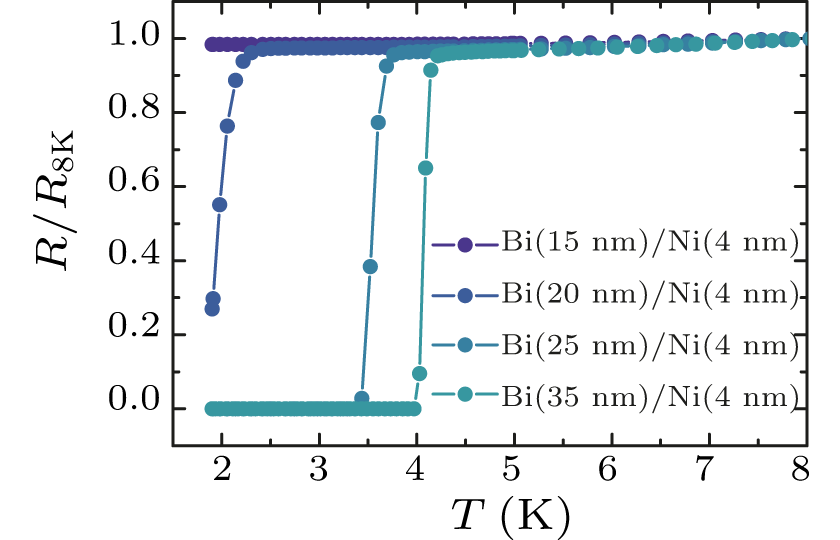| CONDENSED MATTER: ELECTRONIC STRUCTURE, ELECTRICAL, MAGNETIC, AND OPTICAL PROPERTIES |
 |
|

|
|
|
Possible p-Wave Superconductivity in Epitaxial Bi/Ni Bilayers |
| GONG Xin-Xin1,2, ZHOU He-Xin1,2, XU Peng-Chao1,2, YUE Di1,2, ZHU Kai1,2, JIN Xiao-Feng1,2**, TIAN He3, ZHAO Ge-Jian4, CHEN Ting-Yong4 |
1State Key Laboratory of Surface Physics, and Department of Physics, Fudan University, Shanghai 200433
2Collaborative Innovation Center of Advanced Microstructures, Fudan University, Shanghai 210433
3State Key Laboratory of Silicon Materials and School of Materials Science and Engineering, Zhejiang University, Hangzhou 310027
4Department of Physics, Arizona State University, Tempe, AZ 85287, USA |
|
| Cite this article: |
|
GONG Xin-Xin, ZHOU He-Xin, XU Peng-Chao et al 2015 Chin. Phys. Lett. 32 067402 |
|
|
|
|
Abstract Superconductivity (SC) is one of the most intriguing physical phenomena in nature. Nucleation of SC has long been considered highly unfavorable if not impossible near ferromagnetism, in low dimensionality and, above all, out of non-superconductor. Here we report observation of SC with TC near 4 K in Ni/Bi bilayers that defies all known paradigms of superconductivity, where neither ferromagnetic Ni film nor rhombohedra Bi film is superconducting in isolation. This highly unusual SC is independent of the growth order (Ni/Bi or Bi/Ni), but highly sensitive to the constituent layer thicknesses. Most importantly, the SC, distinctively non-s pairing, is triggered from, but does not occur at, the Bi/Ni interface. Using point contact Andreev reflection, we show evidences that the unique SC, naturally compatible with magnetism, is triplet p-wave pairing.
|
|
Received: 07 May 2015
Published: 30 June 2015

|
|
| PACS: |
74.20.Mn
|
(Nonconventional mechanisms)
|
| |
74.20.Rp
|
(Pairing symmetries (other than s-wave))
|
| |
74.78.-w
|
(Superconducting films and low-dimensional structures)
|
|
|
|
|
|
[1] Tinkham M 1996 Introduction to Superconductivity (New York: McGraw-Hill)
[2] Bednorz J G and Müller K A 1986 Z. Phys. B 64 189
[3] Kamihara Y et al 2006 J. Am. Chem. Soc. 128 10012
[4] Ginzburg V L 1957 Sov. Phys. JETP 4 153
[5] Anderson P W and Suhl H 1959 Phys. Rev. 116 898
[6] Fulde P and Ferrel R A 1964 Phys. Rev. 135 A550
[7] Larkin A I and Ovchinnikov Y N 1965 Sov. Phys. JETP 20 762
[8] Buzdin A I 2005 Rev. Mod. Phys. 77 935
[9] Eschrig M 2011 Phys. Today 64 43
[10] Linder J and Robinson J W A 2015 Nat. Phys. 11 307
[11] Moodera J S and Meservey R 1990 Phys. Rev. B 42 179
[12] LeClair P, Moodera J S, Philip J and Heiman D 2005 Phys. Rev. Lett. 94 037006
[13] Reyren N et al 2007 Science 317 1196
[14] Wang Q Y et al 2012 Chin. Phys. Lett. 29 037402
[15] Ashcroft N W and Mermin N D 1976 Solid State Physics (London: Thomson Learning)
[16] Tian C S et al 2005 Phys. Rev. Lett. 94 137210
[17] Yin L F et al 2006 Phys. Rev. Lett. 97 067203
[18] Xu J, Li Y, Hou D, Ye L and Jin X 2013 Appl. Phys. Lett. 102 162401
[19] Schulz B, Schwarzwald R and Baberschke K 1994 Surf. Sci. 307-309 1102
[20] Zhang R J and Willis R F 2001 Phys. Rev. Lett. 86 2665
[21] Xiao S, Wei D and Jin X 2012 Phys. Rev. Lett. 109 166805
[22] Zhu K et al 2014 arXiv:1403.0066[cond-mat.mes-hall]
[23] Konopko L, Huber T and Nikolaeva A 2010 J. Low Temp. Phys. 159 253
[24] Hirahara T et al 2006 Phys. Rev. Lett. 97 146803
[25] Hofmann Ph 2006 Prog. Surf. Sci. 81 191
[26] Koroteev Y M, Bihlmayer G, Chulkov E V and Blügel S 2008 Phys. Rev. B 77 045428
[27] Takayama A, Sato T, Souma S, Oguchi T and Takahashi T 2012 Nano Lett. 12 1776
[28] Chen T Y, Tesanovic Z, Liu R H, Chen X H and Chien C L 2008 Nature 453 1224
[29] Blonder G E, Tinkham M and Klapwijk T M 1982 Phys. Rev. B 25 4515 |
|
Viewed |
|
|
|
Full text
|
|
|
|
|
Abstract
|
|
|
|
|